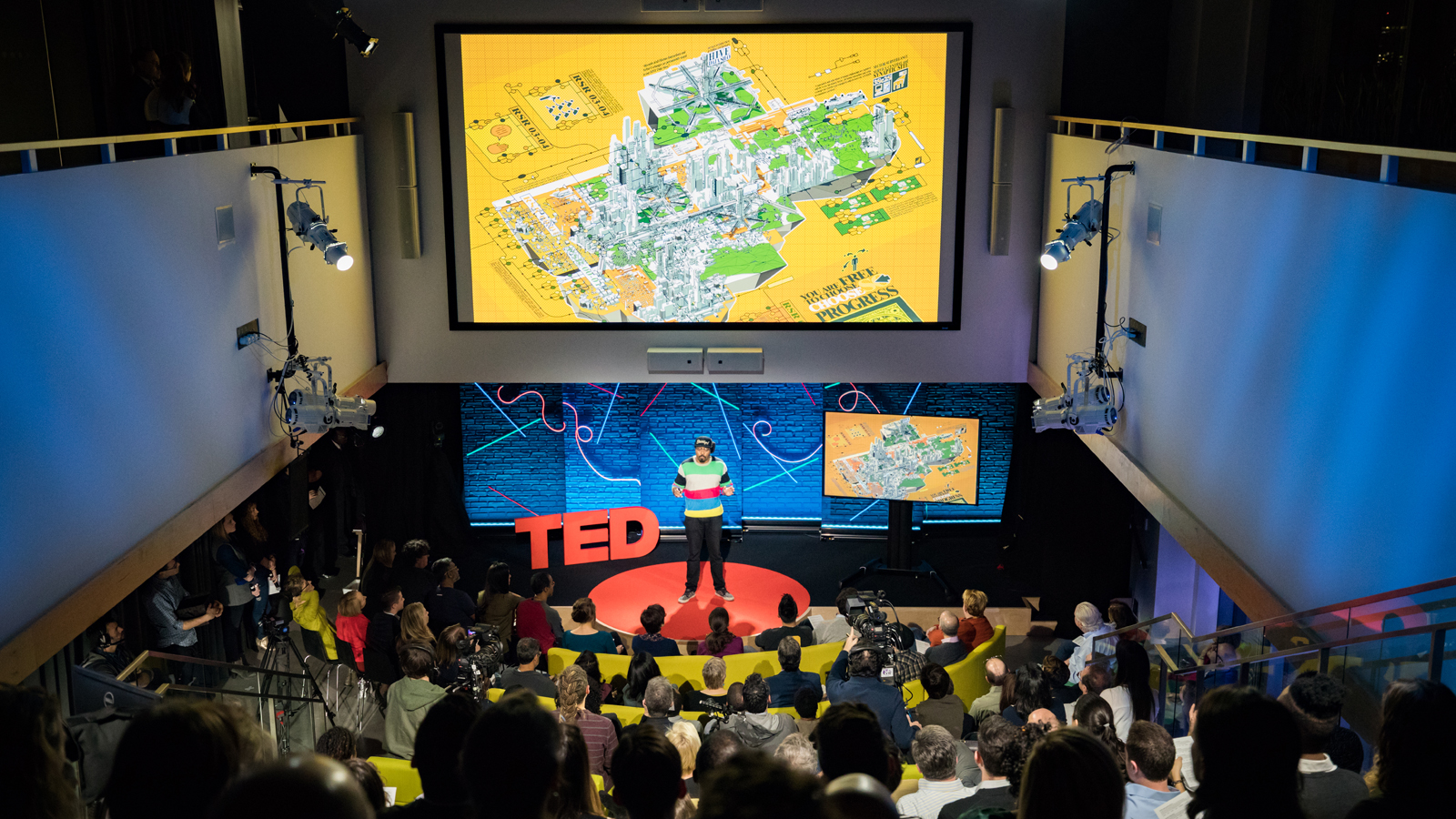
Artist Olalekan Jeyifous kicks off the night at TEDNYC Idea Search 2017 with a gallery of his hyper-detailed and gloriously complex imaginary cities. The event took place January 26, 2017, at TED’s New York headquarters. Photo: Anyssa Samari / TED
Here at TED headquarters, we are constantly looking for new voices, new ideas — and late last year, we opened a challenge to the world: Make a one-minute audition video that makes the case for your TED Talk. On Thursday night, January 26, at our New York office, co-hosts Kelly Stoetzel and Cloe Shasha presented us with eleven audition finalists in a fast-paced program that took us from imaginary shanty towns to the cyborg uprising. (It’s all part of our Idea Search project, and Thursday’s event was the first of three evenings planned — the next two are in Lagos, Nigeria, and Nairobi, Kenya.) Here are voices you may not have heard before — but that you’ll want to hear more from soon …
Dystopian design. Artist Olalekan Jeyifous creates speculative architectural interventions — fantastical, sci-fi-inspired designs that spur inquiry and discourse about the places we live. In an image-packed talk (seriously, check out his work), Jeyifous shows us his future vision for cities like Lagos, Nigeria, where millions of people live and work in improvised buildings cheek-by-jowl with luxury megastructures. With elegant lines and colors, and the kind of detail you could get lost in for days, his work celebrates the organic, eye-popping complexity of our cities.
Designing the “how” conversation. Ask a group of people whether something should happen, and you’ll get a discussion where people take sides and likely end in a stalemate; but ask them how something might happen, and you’ll get a design discussion with room for many voices and, possibly, a solution. In his six-minute talk, David Dylan Thomas suggests that too much of our discourse, both online and off, focuses on telling people what they’re doing wrong instead of on how they could be doing better. “The best thing we can do is ask the right question in the first place,” Thomas says. “The next time you see someone doing it wrong, ask yourself, is there a How conversation to be had?”
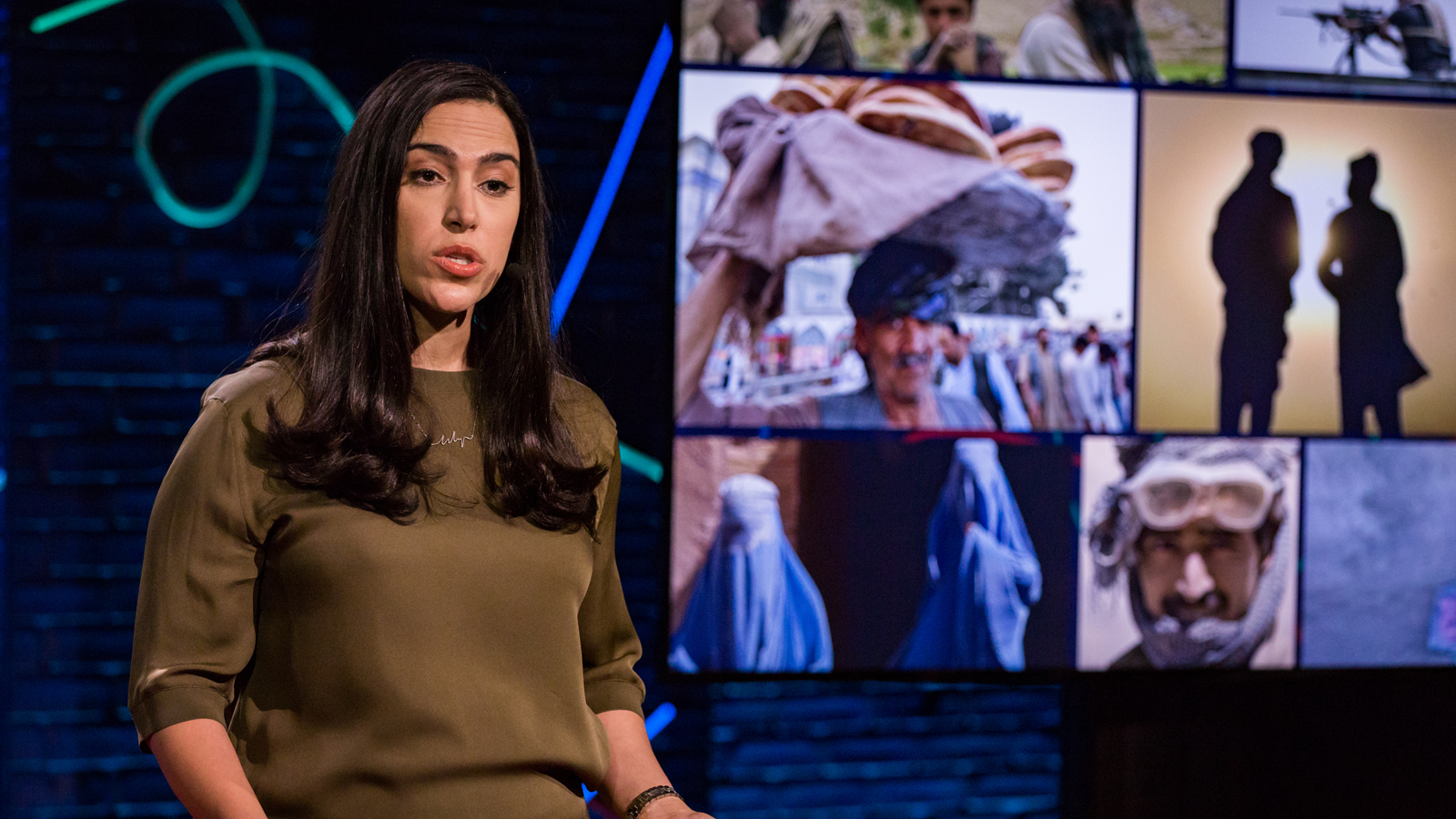
Journalist and “industrious optimist” Lara Setrakian runs Syria Deeply, a news site that covers complex and difficult — and vastly important — global news. As she says, we must “embrace complexity to make sense of a complex world.” Photo: Ryan Lash / TED
The news, deeply. Lara Setrakian was working as a foreign correspondent in the Middle East when she noticed the stories all around her, from conflict zones to climate change, that were going untold by the news industry. Determined not to let Syria become another forgotten story, she left ABC News to found Syria Deeply, a news site that’s dedicated to helping people understand current events in all their complexity. With trust in the media at an all-time low, Setrakian offers a three-point manifesto for fixing the news, never wavering from her belief that for journalism, today is “a time of reawakening and reimagining.”
Life lessons from NYTimes obituaries. By analyzing 2,000 obituaries over a 20-month period, Lux Narayan uncovers the lessons and values that obituaries can teach us about our everyday lives. He found that, when condensed into an obit headline, people are celebrated much more often for their impact on others than for their personal, material success; in fact, one of the most common verbs in an obituary headline is “helped.” The most powerful lesson, he concludes, is that “if more people lived their lives trying to be famous in death, the world would be a much better place.”
How to use an AED, as explained by Star Wars. If Yoda goes into cardiac arrest, will you know what to do? Artist and first-aid enthusiast Todd Scott breaks down everything you need to know about using an Automated External Defibrillator, or AED, in the Star Wars universe (or ours). Everyone in the audience is now prepared to save the life of Yoda, the Ewoks and even Chewbacca the Wookiee (he’ll need a quick shave first).
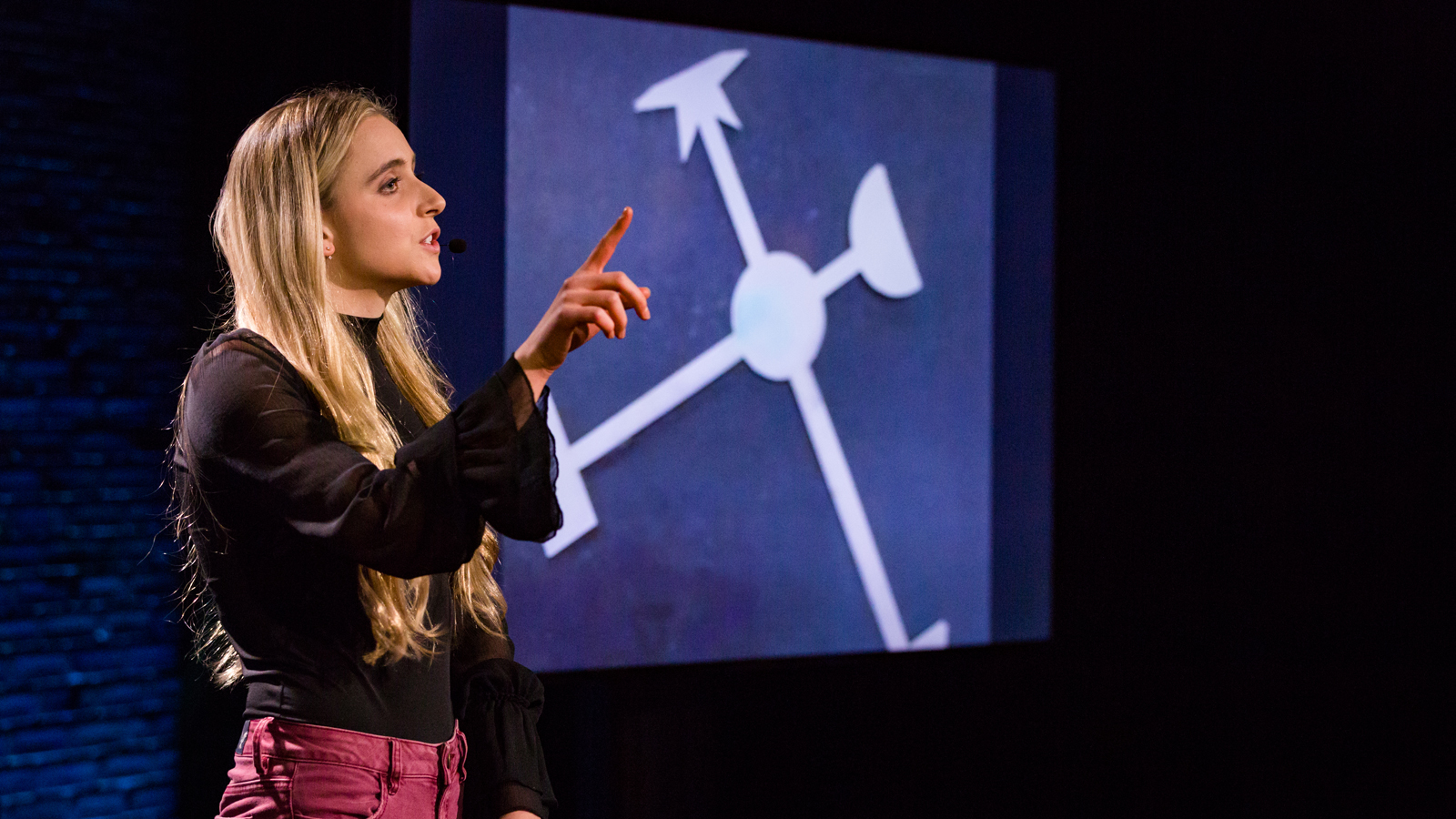
Olivia Hallisey won the 2015 Google Science Fair with this elegant, low-cost diagnostic tool for Ebola. It could someday be used to detect even more conditions, from Lyme disease to certain cancers. Photo: Ryan Lash / TED
A better diagnostic tool for Ebola. Olivia Hallisey was a high school student during the Ebola outbreak, but instead of buying into the media hysteria and public fear, she set out to help by creating a better diagnostic tool. ELISA, the best test available, relied on constant refrigeration, from the moment of manufacture to the moment of testing, and Hallisey was determined to make an Ebola test that was easier to give and take. Her paper-based Ebola Assay uses a technique she learned about in a TED Talk (Fiorenzo Omenetto’s “Silk, the ancient material of the future“) — and it not only requires no refrigeration, but it’s cheap, fast, portable and doesn’t require trained medical personnel.
Standing up to ageism. I want to live in a world, says Ashton Applewhite, where people do not age out of having value as human beings. The founder of the blog Yo, Is This Ageist? and author of This Chair Rocks, Applewhite confronts our socially constructed ideas about old people and asks us instead to celebrate the self-knowledge that comes with maturity. “The longer we live,” she points out, “the more different from one another we become.” She challenges us to stop assuming there’s a line between old and young “after which it is all downhill.”
Break the trap of imposter syndrome. Want to stop feeling like an imposter? Stop thinking like one, says Valerie Young. Many of us have a tendency to discount and downplay our own abilities, a bad habit that can have real consequences on our success. The best way to step out of the imposter syndrome trap, Young says, is to reframe how we see ourselves and our accomplishments — and she shares a few tips for doing just that. The trick? Learn to talk yourself out of your shame spiral and over time, your feelings will follow. As she puts it: “You don’t have to feel confident to act confident.”
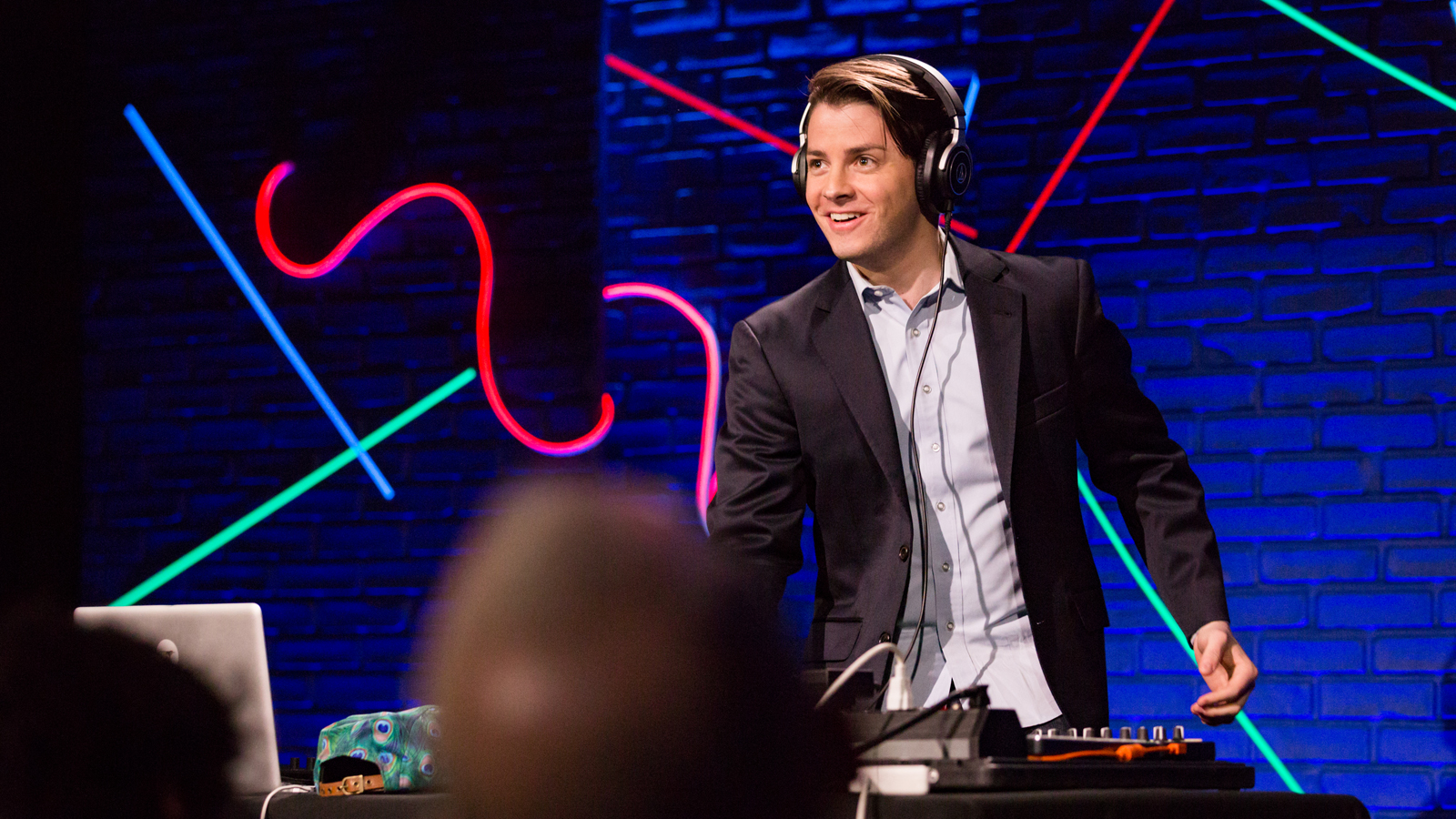
Ben Mirin makes beats out of birdsong and other sounds from the natural world. He DJed a set of whalesong, dolphin beeps, frog croaks and more at TEDNYC Idea Search 2017. Photo: Ryan Lash / TED
The sound of conservation. A lifelong birdwatcher, sound artist and musician Ben Mirin found himself in need of nature after moving to New York City. Using birdsong recordings he found online, he began to put the sounds down to some beats. Now, he travels the world to record the sounds of nature, using the recordings not only for scientific research but to make music that celebrates the beauty and musicality of our world. “Music and art can connect us all to the wild world,” says Mirin; “it turns conservation into an international language that anybody can dance to.”
Searching Watson for ourselves. Nearly every dystopian script related to the future of artificial intelligence involves a conversation about the dangers AI poses for the human race. But according to Elizabeth Kiehner, these fears belong to a future far distant from where we are today. The real concern, she says, lies with our own ethical systems, and how we embed those values in the AI of today — the biases, prejudices, and beliefs we form during our lifetimes. If we’re creating artificial intelligence in our own image, then we need to be careful about the ways in which we actually program it.
Take back our digital DNA. “I used to fear a cyborg uprising,” says Evgeny Chereshnev, “but now I am one.” Two years ago, he had a biochip implanted in his hand. The chip gives him some cool Jedi skills like opening doors and unlocking phones, but it also tracks and records his every move. And it turns out, tracking every second of his digital life has transformed the way he views the collection of our private data — collection that’s happening constantly, often without our notice or permission, and whether or not we have a chip in our hand. Our collected digital habits collected from credit-card shopping, mobile phone records, browsing histories, etc., become a kind of digital DNA, offering marketers “a cheatsheet to your brain, to your life.” He offers a rousing call to take back our privacy, which is “another word for freedom.”
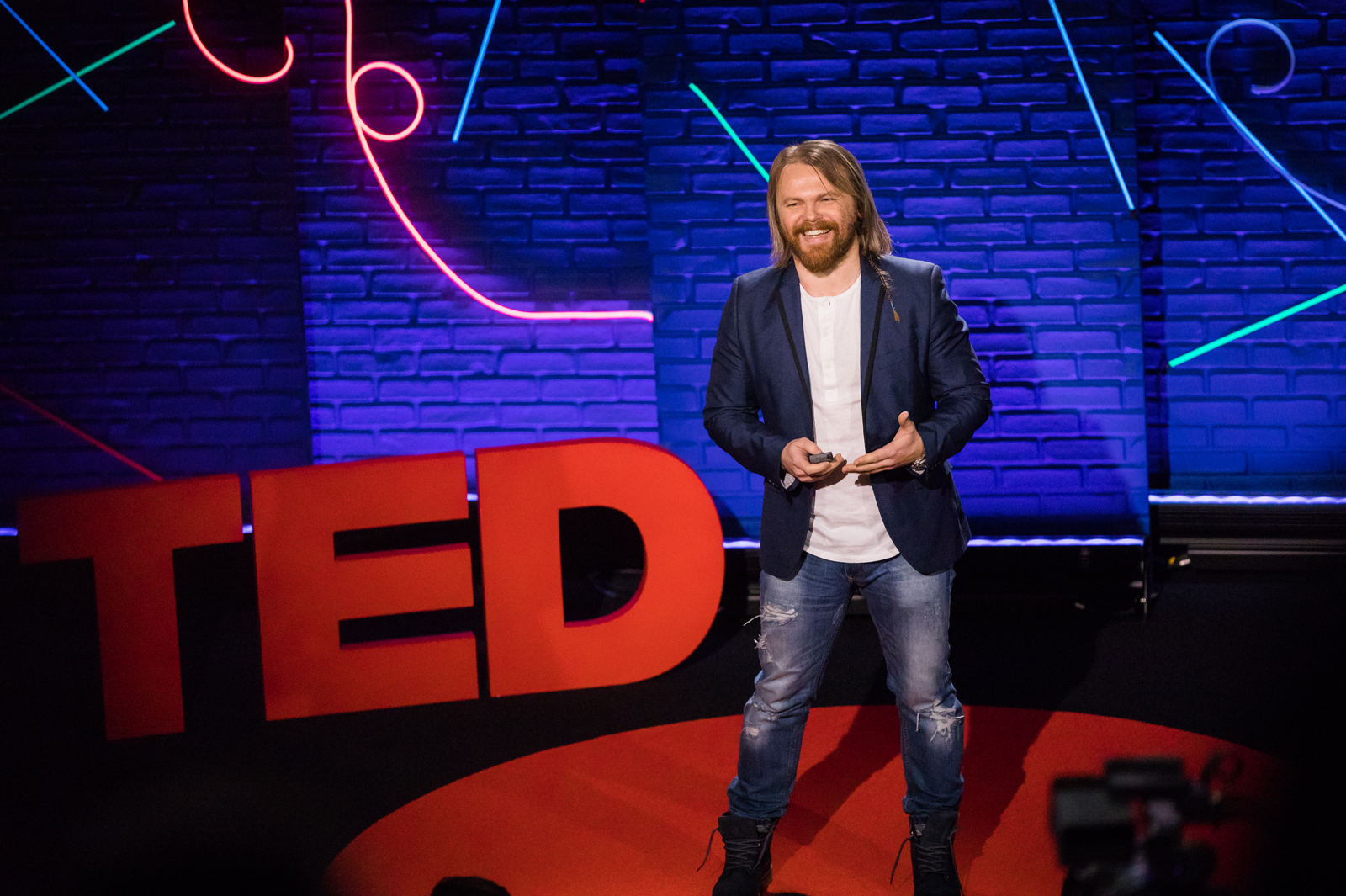
Technologist Evgeny Chereshnev implanted a microchip in his hand so that he’d know what it felt like to be part of the Internet of Things. Photo: Anyssa Samari / TED